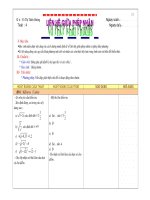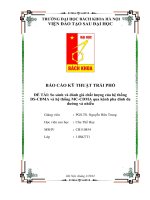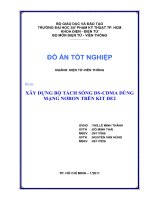MOB sujet 4 Transmission techniques - DS CDMA
Bạn đang xem bản rút gọn của tài liệu. Xem và tải ngay bản đầy đủ của tài liệu tại đây (200.77 KB, 10 trang )
Master of Computer Science 1 - MOB Mobile Internet and Surrounding
1/10 Subject 4
MOB sujet 4
Transmission techniques - DS CDMA
1. CDMA Exercises
The principle of the spread spectrum modulation consists in coding the information by the way
of a bandwidth signal larger than the band strictly necessary, with a goal of fighting the interfering
signals and the distortions tied with the propagation.
The signal is coded at the beginning: a code is assigned with each user in order to allow
decoding in the arrival. The spread is ensured by a pseudo-random signal called spread code. At
the reception, the signal is seen as the noise if the receiver does not have the code.
The spread spectrum modulation is optimized to fight against the noise, by which it limit better
the effects.
1.0.1 Mathematical reminds
- Correlation measure the manner whose two signals vary simultaneously. A strong
correlation implies a great resemblance between the two compared signals.
- Auto-correction quantifies the correlation of a signal with a version of itself shifted in
time, according to this temporal shift.
- Cross-correlation quantifies the correlation of two shifted signals the one in comparing
with the other in time, according to this temporal shift.
- Orthogonality: two periodic signals from period T are known as orthogonal if their
cross-correlation is null for a null temporal shift.
CDMA modulation (Code Division Multiple Access) is a spread spectrum modulation. It
allows transmitting two signals simultaneously in the same band, their separation being realized at
the reception in getting profit of their orthogonality. Several mobile telephony systems (IS95,
UMTS…) have chooses this technique. The CDMA is then also used in order to manage the
multi-users aspect. Among the spread spectrum methods are:
- Frequency Hopping - CDMA (FH-CDMA), seemed to be the most interesting technique
at the beginning, but its difficult implementation took the interest back on spread spectrum
by directed sequence;
- Direct Sequence - CDMA (DS-CDMA), is used in particular in the 3G European UMTS
system (Mobile Universal Telephone System).
The principle of the DSCDMA is as follows. On each transmitting station, is allocated a
single code of m chips called "chip sequence" constituted from "-1" and from "+1". To
transmit a bit to "1", the station sends its sequence chip. To transmit a bit to “0”, the station
sends the opposite of its sequence chip. The duration T
c
of transmission of a chip is m time
lower than the duration T
b
of a bit.
Example: let us suppose that the chip sequence of A is "-1-11-1111-1 " (m = 8). To transmit
Master of Computer Science 1 - MOB Mobile Internet and Surrounding
2/10 Subject 4
a binary "1", A sends "-1-11-1111-1"; to transmit a binary "0", A sends "11-11-1-1-11"
Power spectral density (PSD) of a signal corresponds to the power distribution of the signal
according to the frequency. For a code of forming, the PSD is proportional to the square of
the Fourier transform of this forming. The forming is a form of wave given starting from
which one announces a "0" or a "1". If this is about one rectangular function of width T, the
Fourier transform of such a function is a cardinal sine whose first cancellation is of f = 1/T.
One thus finds a PSD which has the form of the square of a cardinal sine:
A signal DS-CDMA corresponds to a succession of rectangles of width T
c
, the duration of
a chip. Its PSD thus has the form of the square of a cardinal sine in the first cancellation by
f = 1/T
c
.
By opposition, a digital signal is constituted by a succession of rectangles of width T
b
, the
bit duration, has a PSD of the form of the square of a cardinal sine with the first
cancellation of f = 1/T
b
.
The chip sequence consists of m chips. Each bit of the digital signal in starting is replaced
by the chip code so that T
b
= mT
c
. And thus,
T
m
T
b
C
1
The principal lobe of DS-CDMA signal is thus m time broader than the principal lobe of
the starting signal. It is said that the signal was spread with a spread factor of m. Two
signals have the same total power, but power of the starting signal is more concentrated in
the band, where the appellation of “signal with narrow-band ".
1.0.2 Exercises
1. In your opinion, what are the advantages and disadvantages in the use of the CDMA for the
cellular networks?
Advantages: The spread spectrum modulation is optimized to fight against the noise, by
which it limit better the effects.
Disadvantages: In CDMA, any speaker can talk at any time; however each uses a different
language. Each listener can only understand the language of their partner. As more and
more couples talk, the background noise (representing the noise floor) gets louder, but
because of the difference in languages, conversations do not mix.
2. If one wishes to send information of b bits/s with a key of m chips, what will be the flow in
chips per second?
The chip sequence is constituted of m chips. Each bit digital signal of departure is replaced
by the code chip so that T
b
= mT
c
. So,
b
bc
c
mf
T
m
T
f
1
.
According to Shannon’s theorem, we deduce: C
c
= mC
b
= mb chips/s.
3. Which factor will the frequency band occupied by the signal be increased with?
The data bit rate and noise power ratio.
Master of Computer Science 1 - MOB Mobile Internet and Surrounding
3/10 Subject 4
The main lobe of DS-CDMA signal is m times larger than the main lobe of the signal of
departure. The frequency band occupied is increased by a factor m. They say that the signal
was unfurled with a spreading factor of m. Both signals have the same overall power, but
the signal of departure is more concentrated in the band, hence the name "narrow band
signal”.
4. Two keys are orthogonal if the standardized internal product of these both keys is null.
Remind: internal product of [a, b] [a’, b’] = a a’ + b b’.
Show that if two keys S and T are orthogonal, S and
__
T
are too.
Suppose S = [s
1
, s
2
,..,s
m
], T = [t
1
, t
2
,…,t
m
]
Thus
__
T
= [t
1
, t
2
,…, t
m
]
We have S T = (s
1
t
1
+ s
2
t
2
+ … + s
m
t
m
)/m = 0
So S
__
T
= (s
1
t
1
+ s
2
t
2
+ … + s
m
t
m
)/m = (s
1
t
1
+ s
2
t
2
+ … + s
m
t
m
)/m = 0
e.g S and
__
T
are orthogonal.
5. One considers 4 transmitters having each one a key:
A: (-1 -1 -1 +1 +1 -1 +1 +1)
B: (-1 -1 +1 -1 +1 +1 +1 -1)
C: (-1 +1 -1 +1 +1 +1 -1 -1)
D: (-1 +1 -1 -1 -1 -1 +1 -1)
a) Show that B, C and D are orthogonal at A.
A B = [(-1) (-1) + (-1) (-1) + (-1) (+1) + (+1) (-1) + (+1) (+1) + (-1) (+1) + (+1)
(+1) + (-1) (-1)]/8 = (1 + 1 – 1 – 1 + 1 – 1 + 1 – 1)/8 = 0
b) A code has a good autocorrelation if its product intern with itself is high and its internal
product with itself is shifted of 1 or several chips are weak. That means that the receiver
will be able to recognize easily the emitted signal. Show that the key of Barker
(+1,-1,+1,+1, -1, +1,+1,+1, -1,-1,-1) is a good autocorrelation.
We have: Bk Bk = 1
The value is even more important that the key is long, but it takes to get complete the
concept of autocorrelation view the product's internal key with it even when it is offset by 1
chip, 2 chips, ...
Suppose Bk’ is Bk shifted of 1 chip to the left, thus:
Bk’ = (-1,+1,+1, -1, +1,+1,+1, -1,-1,-1,+1).
We have: Bk Bk’ = [1 x (-1) + (-1) x 1 + 1 x 1 + 1 x (-1) + (-1) x 1 + 1 x 1 + 1 x 1 + 1 x
(-1) + (-1) x (-1) + (-1) x (-1) + (-1) x 1]/11 = [(-1) + (-1) + 1 + (-1) + (-1) + 1 + 1 + (-1) + 1
+ 1 + 1]/11 = –1/11
The product of the key Barker (+1 -1 +1 +1 -1 +1 +1 +1 -1 -1 -1) with the same key but
shifted by two chips to the left, Bk” (+1 +1 -1 +1 +1 +1 -1 -1 -1 +1 -1) is:
Bk Bk” = (1 – 1 – 1 + 1 – 1 + 1 – 1 – 1 + 1 – 1 + 1)/11 = –1/11
We deduce that this key and the same key shifted by one chip or two chips are nearly
orthogonal. The higher the value of domestic product, the lower the receiver can easily
Master of Computer Science 1 - MOB Mobile Internet and Surrounding
4/10 Subject 4
interpret the result (signal codes with keys "pseudo-orthogonal").
c) When a station wants to transmit a binary "1", it sends its key and when it wants to
transmit a binary "0", it sends the opposite of this key. If only C wishes to send a bit of
"1", what the receiver will receive and will make to interpret the answer?
If only C wishes to send a bit of "1", C send chip sequence S = (-1 +1 -1 +1 +1 +1 -1 -1).
The receiver will calculate, it had: S A = 0 and S B = 0 and S D = 0 and S C = 1, so
receiver know C was sent bit "1".
d) If only C wishes to send a bit of "0", what the receiver will receive and will make to
interpret the answer?
If C send a binary "0", C send chip sequence S = (+1 -1 +1 -1 -1 -1 +1 +1).
The receiver will calculate, it had: S A = 0 and S B = 0 and S D = 0 and S C = –1, so
receiver know C was sent bit "0".
e) The signals are added linearly, the transmitters are synchronous and the signals are
received with the same power by the receiver. If one supposes that the stations A, B
and C decide to send at the same time the bit "0", what will be the sequence read by
receiver?
The stations A, B and C decide to send at the same time the bit "0", chip sequence S at the
receiver:
S = (+3 +1 +1 -1 -3 -1 -1 +1)
(Remember we have:
A
= (+1 +1 +1 -1 -1 +1 -1 -1) and
B
= (+1 +1 -1 +1 -1 -1 -1 +1) and
C
= (+1 -1 +1 -1 -1 -1 +1 +1) )
f) If the receiver receives the sequence “-1 +1 -3 +1 -1 -3 +1 +1”, what does it deduce
from?
Suppose S = (-1 +1 -3 +1 -1 -3 +1 +1)
We have:
S A = (-1 +1 -3 +1 -1 -3 +1 +1) (-1 -1 -1 +1 +1 -1 +1 +1) = (1 - 1 + 3 + 1 – 1 + 3 + 1 +
1)/8 = 1, so A sent bit “1”.
S B = (-1 +1 -3 +1 -1 -3 +1 +1) (-1 -1 +1 -1 +1 +1 +1 -1) = (1 – 1 – 3 – 1 – 1 – 3 + 1 –
1)/8 = -1, so B sent bit “0”.
S C = (-1 +1 -3 +1 -1 -3 +1 +1) (-1 +1 -1 +1 +1 +1 -1 -1) = (1 + 1 + 3 +1 – 1 – 3 – 1 – 1)/8
= 0, so C has not sent anything.
S D = (-1 +1 -3 +1 -1 -3 +1 +1) (-1 +1 -1 -1 -1 -1 +1 -1) = (1 + 1 + 3 – 1 + 1 + 3 + 1 – 1)/8
= 1, so D sent bit “1”.
6. Suppose that one wants to transmit a data flow of 56 kbit/s by using a spread spectrum
technique.
a) Find the band-width of the necessary channel when the signal-with-noise report is 0,1;
0,01 and 0,001.
Case 1: SNR = 0,1
C = B log
2
(1 + SNR) B = C / log
2
(1 + SNR) = 56 10
3
/ log
2
(1 + 0,1) = 407.262Hz
407,2KHz
Master of Computer Science 1 - MOB Mobile Internet and Surrounding
5/10 Subject 4
Case 2: SNR = 0,01
C = B log
2
(1 + SNR) B = C / log
2
(1 + SNR) = 56 10
3
/ log
2
(1 + 0,01) = 3.901.000Hz
3,9 MHz
Case 3: SNR = 0,001
C = B log
2
(1 + SNR) B = C / log
2
(1 + SNR) = 56 10
3
/ log
2
(1 + 0,001) = 38.835.647Hz
38,835 MHz
b) In a ordinary system (without spread spectrum)
In a regular system (without spread-spectrum), so that R = B
Shannon's formula C = Blog
2
(1 + S / N) applied with C = B = R gives
log
2
(1 + S / N) = 1. This implies that S / N = 1. Thus, spread-spectrum without a S / N
much greater is required.
7. Prove that a receiving station can get the data sent by a specific sender if it multiplies the
entire data on the channel by the sender’s chip code and then divides it by the number of
stations.
Let us prove this for the first station, using our previous four-station example. We can say that
the data on the channel:
D = (d1 c1 + d2 c2 + d3 c3 + d4 c4)
The receiver which wants to get the data sent by station 1 multiplies these data by c1.
D c1 = (d1 c1 + d2 c2 + d3 c3 + d4 c4) c1
= d1 c1 c1 + d2 c2 c1 + d3 c3 c1 + d4 c4 c1
= d1 N + d2 0 + d3 0 + d4 0
d1 = (D c1 ) / N
2. Practical - Spread spectrum techniques
The goal of this practical is to understand the impact of spread spectrum techniques on the
emitted signal and on the received signal by the recipient. You will be able with this practical:
– to visualize and study impact of the code used and of the modulation type on the spectrum
of a signal;
– to observe the properties of two signals according to the used keys (DS-CDMA);
– to visualize quality of reception of a signal 1, while varying the signal with noise report
(SNR) as well as the ratio (C/I) of the power of the signal has to interpret (Carrier: signal 1)
by compared with a second signal (Interferor: signal 2) which will come to disturb the
reception of the first;
– to trace the curves of Bit Error Rate (BER), according to coding for a SNR or a fixed C/I.
For that you will use the simulation tool developed for this effect. Copy the script tme_cdma in
your folder:
Carry out the script with the help of Octave, the digital calculation, visualization and programming









